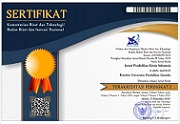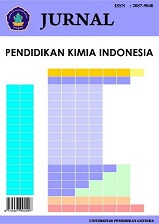The Influence of the STAD and NHT Learning Models on Students' Cognitive Achievement and Learning Motivation on Colloid Material in Banyumas
DOI:
https://doi.org/10.23887/jpki.v8i2.79261Keywords:
NHT, STAD, Cognitive Achievement, Learning Motivation, ColloidAbstract
This study aims to assess the impact of the Student Team Achievement Division (STAD) and Numbered Head Together (NHT) learning models on students’ cognitive achievement and learning motivation in colloidal material at MA Negeri 1 Banyumas. The study uses a quantitative approach with a quasi-experimental design, involving students from six XI science classes of MA Negeri 1 Banyumas. The first experimental group was taught using the STAD model, while the second group was taught using the NHT model. The sampling technique used was random sampling. Instruments included multiple-choice tests to measure cognitive achievement and learning motivation. Data analysis was carried out using an independent t-test. The results showed that both the STAD and NHT models had a significant impact on students’ cognitive achievement and learning motivation in colloid material. The p-values for the NHT learning model were 0.47 and 0.39, while the p-values for the STAD learning model were 0.17 and 0.16.
References
Amineh, R. J., & Asl, H. D. (2015). Review of constructivism and social constructivism. Journal of Social Sciences, Literature and Languages, 1(1), 9–16.
Ardiyansyah, A., Junaidi, E., & Hadisaputra, S. (2019). The effect of implementing the student team achievement division (STAD) type cooperative learning model assisted by student worksheets (LKS) on chemistry learning outcomes. Chemistry Education Practice, 2(2), 44–49.
Arikunto, S. (2019). Prosedur Penelitian. Rineka Cipta.
Basyah, N. A., Yunus, M. M., Fahmi, I., Jalil, Z. A., & Rusli, Z. (2021). The influence of the student team achievement division model on communication skills in economics subjects. Journal of E-Learning and Knowledge Society, 17(2), 74–84.
Damopolii, I., & Rahman, S. R. (2019). The effect of STAD learning model and science comics on cognitive students’ achievement. In Journal of Physics: Conference Series, 1157.
Erly, E. (2020). Student Teams Achievement Divisions (STAD) Cooperative Learning Model: Its Impact on Student Learning Motivation. Indonesian Journal of Science and Mathematics Education, 3(1), 1–8.
Ertin, L. K. N., Bunga, Y. N., & Galis, R. (2021). The influence of the numbered heads together (NHT) and jigsaw type cooperative learning models on students’ activeness and cognitive learning outcomes in class X biodiversity material at SMA N 2 Maumere. Spizaetus: Journal of Biology and Biology Education, 2(3), 9–17.
Fatoyah, S., Nayazik, A., & Wahyuni, A. (2020). Comparative study of mathematics learning outcomes using the Numbered Heads Together (NHT) and Student Teams Achievement Division (STAD) cooperative learning models. Al Qalasadi Mathematics Education Scientific Journal, 4(1), 50–55.
Firman, F., Mirnawati, M., Hisbullah, H., Usman, U., Ramadhan, M. A., & Harianto, E. (2021). How to apply the numbered heads together learning model to improve Indonesian Learning Outcomes of Middle School Studentse. Journal of Learning Research and Innovation, 1(2), 59–70.
Hidanurhayati, H., Sihaloho, M., & La Kilo, A. (2018). The influence of the numbered heads together (NHT) learning model accompanied by smart card media on student learning achievement in class XI buffer solution material at SMA Negeri 1 Kabila. Jambura Journal of Educational Chemistry, 13(2), 233–240.
Huda, N., & Rohaeti, E. (2023). The Factors that Influence the Motivation to Learn Chemistry of Upper-Secondary School Students in Indonesia. Journal of Baltic Science Education, 22(4), 615–630. https://doi.org/10.33225/jbse/23.22.615
Ilhamdi, M. I., Novita, D., & Rosyidah, A. N. K. (2020). The influence of the guided inquiry learning model on critical thinking skills in elementary school science. CONTEXTUAL Scientific Journal, 1(2), 49–57.
Jampel, I. N., Fahrurrozi, F., Artawan, G., Widiana, I. W., Parmiti, D. P., & Hellman, J. (2018). Studying Natural Science in Elementary School Using NOS-Oriented Cooperative Learning Model with the NHT Type. Jurnal Pendidikan IPA Indonesia, 7(2), 138–146. https://doi.org/10.15294/jpii.v7i2.9863
Kaya, Z., & Emre, İ. (2020). Elementary Teacher Candidates’ Opinions About Science and Scientific Research. International Journal of Academic Research in Education, 6(1), 34–45. https://doi.org/10.17985/ijare.814259
Kodang, D. D., Bano, V. O., & Ndjoeroemana, Y. N. (2022). Application of the Student Team Achievement Division (STAD) Cooperative Model to student learning outcomes at SMP Negeri 2 Nggoa. Kridatama Journal of Science and Technology, 4(2), 104–115.
Leasa, M., & Corebima, A. D. (2017). The effect of numbered heads together (NHT) cooperative learning model on the cognitive achievement of students with different academic abilities. In Journal of Physics: Conference Series, 795(1). https://doi.org/012071
Lin, C.-Y., & Wu, H.-K. (2021). Effects of different ways of using visualizations on high school students’ electrochemistry conceptual understanding and motivation towards chemistry learning. Chemistry Education Research and Practice, 22(3), 786–801. https://doi.org/10.1039/D0RP00308E
Malino, A. I. (2019). Increasing chemistry learning outcomes for students in class. Journal of Learning Thought and Development, 1(2), 1–14.
Murtiyasa, B., & Hapsari, S. N. (2020). The effect of TAI and STAD strategy towards learning outcomes reviewed from mathematical communication skills. Universal Journal of Educational Research, 8(6), 2406–2415.
Mustami, M. K., & Safitri, D. (2018). The Effects of Numbered Heads Together-Assurance Relevance Interest Assessment Satisfaction on Students’ Motivation. International Journal of Instruction, 11(3), 123–134. https://doi.org/10.12973/iji.2018.1139a
Muzayyin, M. D., Syahputra, N., & Aini, D. K. (2024). Meta-Analysis of the Numbered Head Together Learning Model on Learning Motivation and Comparison of Its Effectiveness at the Elementary to Senior High School in Indonesia. PALAPA, 12(1), 62–77. https://doi.org/10.36088/palapa.v12i1.4684
Naibaho, L. (2019). The effectiveness of number heads together strategy on improving students’ English achievement at XYZ school. International Journal of Research-GRANTHAALAYAH, 7(10), 362–670.
Nazari, A., Tabatabei, O., & Shahreza, M. A. H. (2022). The Impact of STAD Model of CL on Overall Achievements and Creativity of Iranian EFL Learners. Language and Translation, 12(1), 125–139.
Pinontoan, M. M., & Pinontoan, M. (2019). Number heads together model in social learning. In In 5th International Conference on Education and Technology (ICET 2019) (pp. 212–216). Atlantis Press.
Rukiah, R., & Yuliza, Y. (2019). Pengaruh model pembelajaran kooperatif tipe numbered head together (NHT) dengan menggunakan media power point terhadap minat dan hasil belajar kimia siswa di SMA Idhata Kota Bengkulu. Kependidikan, 2(25), 35–44.
Ryan, R. M., & Deci, E. L. (2000). Self-determination theory and the facilitation of intrinsic motivation, social development, and well-being. American Psychologist, 55(1), 68–78. https://doi.org/10.1037/0003-066X.55.1.68
Saputro, A. N. C., Suhelayanti, S., Chabibah, N., Bermuli, J. E., Sinaga, K., Fauzi, A., & Fayanto, S. (2021). Science learning. We Write Foundation.
Setyaningsih, S., & Suchyadi, Y. (2021). Implementation of Principal Academic Supervision to Improve Teacher Performance in North Bogor. JHSS (Journal of Humanities and Social Studies), 5(2), 179–183. https://doi.org/10.33751/jhss.v5i2.3909
Silalahi, M., Siregar, G. A., & Naibaho, L. (2023). The Integration of Cooperative Learning Model on English Language Learning In Fostered Elementary School of Simalungun University. English Review: Journal of English Education, 11(3), 963–970. https://doi.org/10.25134/erjee.v11i3.7574
Silalahi, T. F., & Hutauruk, A. F. (2020). The application of cooperative learning model during online learning in the pandemic period. Budapest International Research and Critics Institute-Journal (BIRCI-Journal), 3(3).
Sugiyono. (2017). Quantitative, qualitative and R&D research methods. Alfabeta.
Syakur, A., & Sabat, Y. (2020). The effectiveness of cooperative learning (STAD and PBL type) on E-learning sustainable development in higher education. Journal of Development Research, 4(1), 53–61.
Tokan, M. K., & Imaculata, M. M. (2019). The effect of motivation and learning behavior on student achievement. South African Journal of Education, 39(1).
Vostal, B. R., Oehrtman, J. P., & Gilfillan, B. (2023). School Counselors Engaging All Students: Universal Design for Learning in Classroom Lesson Planning. Professional School Counseling, 27(1). https://doi.org/10.1177/2156759X231203199
Wahyuni, P. (2019). The effect of cooperative learning type student teams achievement division (STAD) on understanding mathematical concepts in class VIII students of MTs N Pekanbaru. International Journal of Trends in Mathematics Education Research, 2(3), 168–172.
Wahyuningsih, E. S. (2020). The mastery learning learning model is an effort to increase student activity and learning outcomes. Deepublish.
Widyaningtyas, H., Winarni, R., & Murwaningsih, T. (2018). Developing students’ responsibility through numbered heads together model in social science learning at elementary school. Int. J. Indonesia. Educ. Teach, 2(2), 112–119.
Widyastuti, R. (2021). Mathematical problem-solving ability: The effect of numbered heads together (NHT) model and mathematical prior knowledge. Journal of Advanced Sciences and Mathematics Education, 1(2), 73–78.
Zahara, E., Murni, A., & Hutapea, N. (2020). Development of mathematics learning tools by implementing numbered heads together type cooperative models to improve students’ mathematical understanding ability in matrix topics. Journal of Educational Sciences, 4(4), 190–204.
Downloads
Published
How to Cite
Issue
Section
License
Copyright (c) 2024 muhammad rasyid nafi

This work is licensed under a Creative Commons Attribution-ShareAlike 4.0 International License.
Authors who publish with the Jurnal Pendidikan Kimia Indonesia agree to the following terms:
- Authors retain copyright and grant the journal the right of first publication with the work simultaneously licensed under a Creative Commons Attribution License (CC BY-SA 4.0) that allows others to share the work with an acknowledgment of the work's authorship and initial publication in this journal.
- Authors are able to enter into separate, additional contractual arrangements for the non-exclusive distribution of the journal's published version of the work (e.g., post it to an institutional repository or publish it in a book), with an acknowledgment of its initial publication in this journal.
- Authors are permitted and encouraged to post their work online (e.g., in institutional repositories or on their website) prior to and during the submission process, as it can lead to productive exchanges, as well as earlier and greater citation of published work. (See The Effect of Open Access)





